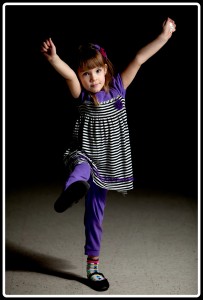 Way back in January I talked a little bit about playing karate with my little girl. At the time I had all kinds of things to say about her learning respect and trust and large motor skills all in one little activity.
Way back in January I talked a little bit about playing karate with my little girl. At the time I had all kinds of things to say about her learning respect and trust and large motor skills all in one little activity.
At the time, I referred to it as one of her favorite games to play with me. That hasn’t changed much in the last five months. I’m surprised how often I’ll come home and she’ll say, “Hey, Dad, let’s play karate! I want to show you my new kick!”
Invariably, it’s a terrible kick. Poorly designed, poorly executed. I don’t tell her that, but I let her try it out and then I calmly, patiently push her over.
Another of her favorite activities is to discuss general anatomy. That’s not euphemistic of anything. She likes to hear about the heart and stomach and lungs and the vascular system and how all the different parts work together. Especially at bedtime, when sitting through a little lecture gives her an excuse to stay awake a while longer.
And she finds bones fascinating. (Still no euphemism!) Last week at bedtime she asked me how bones work, and since we’ve focused so much on organs so far, I started off with their protective properties.
I asked her to point to some bones and she clutched at her rib cage (those are her favorite), and I asked, “What’s inside there?”
“Lungs!” she said. “Like balloons. Ooh, and my heart!”
“Right,” I said. “And are those important?”
She nodded, so I threw a little fake punch at her heart, and her eyes got really wide. Then I said, “What happened?”
She thought for a moment. “My bones protected them!”
I repeated the same process with her brain, and she got to learn the word “skull.”
Then I was about ready to call an end to the day’s lesson when she caught my sleeve and said, “Wait! What about the stomach?” I looked at her and raised an eyebrow, and she drummed on her tummy a couple times. “No bones.”
I said, “Ooh, good point! Stand up.” She stood up. I said, “Karate stance.” She giggled and took her karate stance. Then I did the same thing I’d done before. I threw a slow punch at her stomach.
And she did what I’d trained her to do. She blocked with her hands. I hit them and looked up at her, and she just stared at me for a moment. Then she raised her hands, fingers spread, and stared at them with wide eyes.
Then she thrust them out at me, like she was showing off a new toy, and she shouted, “Bones!” She laughed and looked at them again. She sank down on the edge of her bed, marveling, and shook her head in slow understanding. “So that’s why!”
I kissed her goodnight and left her trying to count the bones in her hand. I couldn’t stop grinning. She’s such a smart little girl. I was halfway to the door when she stopped me with a word.
“Dad?” she said.
I turned and met her eyes. “Time for bed, honey. We’ll talk more tomorrow.”
She nodded sharply, but I could see the question burning in her eyes.
I chuckled. “What?”
She picked up her leg and showed it to me. She pointed to her kneecap. “What does this protect?” Before I could find an answer, she frowned in thought and said, “Just the tunnels? Veins, I mean.”
I smiled back. “Yep. That’s about right. I’ll tell you more tomorrow. Good night.”
So we left it at that. Of course, bones are useful for more than just protecting the fragile bits. They also serve a major structural purpose. They hold us up and fit together in such a way as to move us around.
For such simple pieces, they serve a variety of purposes and work together in ways that are going to take a little while to explain (especially to a four-year-old). Still, she’s asking questions. That’s the important bit.
And in case you’re here for storytelling advice instead of cutesy stories bragging about how brilliant my preschooler is… well, those are on their way. Last time we got together I was talking about the important of reader questions, and how they build the structure of your story. Come back Thursday and we’ll talk about the bones.





